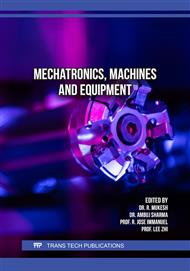[1]
Arslan, N., Demirel, H.: The impact of temporal ionospheric gradients in Northern Europe on relative GPS positioning. Journal of Atmospheric and Solar-Terrestrial Physics. 70, 1382–1400 (2008)
DOI: 10.1016/j.jastp.2008.03.010
Google Scholar
[2]
Budtho, J., Supnithi, P., Saito, S.: Single-Frequency Time-Step Ionospheric Delay Gradient Estimation at Low-Latitude Stations. IEEE Access. 8, 201516–201526 (2020)
DOI: 10.1109/ACCESS.2020.3035247
Google Scholar
[3]
Chandra, K.R., Srinivas, V.S., Sarma, A.D.: Investigation of ionospheric gradients for GAGAN application. Earth Planet Sp. 61, 633–635 (2009)
DOI: 10.1186/BF03352939
Google Scholar
[4]
Dabbakuti, J.R.K.K., Devanaboyina, V.R., Kanchumarthi, S.R.: Analysis of local ionospheric variability based on SVD and MDS at low-latitude GNSS stations. Earth Planet Sp. 68, 94 (2016)
DOI: 10.1186/s40623-016-0478-1
Google Scholar
[5]
Hein, W.Z., Kashiwa, Y., Goto, Y., Kasahara, Y.: Estimation method of ionospheric TEC distribution from single frequency GPS measurements using a slant effect model. In: 2016 URSI Asia-Pacific Radio Science Conference (URSI AP-RASC). p.104–106 (2016)
DOI: 10.1109/ursiap-rasc.2016.7601361
Google Scholar
[6]
Jakowski, N., Hoque, M.M.: Estimation of Spatial Gradients and Temporal Variations of the Total Electron Content Using Ground-Based GNSS Measurements. Space Weather. 17, 339–356 (2019)
DOI: 10.1029/2018SW002119
Google Scholar
[7]
Jakowski, N., Mielich, J., Borries, C., Cander, L., Krankowski, A., Nava, B., Stankov, S.M.: Large-scale ionospheric gradients over Europe observed in October 2003. Journal of Atmospheric and Solar-Terrestrial Physics. 70, 1894–1903 (2008)
DOI: 10.1016/j.jastp.2008.03.020
Google Scholar
[8]
Jing, J., Khanafseh, S., Chan, F.-C., Langel, S., Pervan, B.: Detecting ionospheric gradients for GBAS using a null space monitor. In: Proceedings of the 2012 IEEE/ION Position, Location and Navigation Symposium. p.1125–1133 (2012)
DOI: 10.1109/plans.2012.6236967
Google Scholar
[9]
Kowsik, J., Kumar, T.B., Mounika, G., Ratnam, D.V., Raghunath, S.: Detection of ionospheric anomalies based on FFT Averaging Ratio (FAR) algorithm. In: 2015 International Conference on Innovations in Information, Embedded and Communication Systems (ICIIECS). p.1–3 (2015)
DOI: 10.1109/iciiecs.2015.7192923
Google Scholar
[10]
Lee, J., Pullen, S., Datta-Barua, S., Enge, P.: Assessment of Nominal Ionosphere Spatial Decorrelation for LAAS. In: 2006 IEEE/ION Position, Location, And Navigation Symposium. p.506–514 (2006)
DOI: 10.1109/plans.2006.1650638
Google Scholar
[11]
Lee, J., Pullen, S., Datta-Barua, S., Enge, P.: Assessment of Ionosphere Spatial Decorrelation for Global Positioning System-Based Aircraft Landing Systems. Journal of Aircraft. 44, 1662–1669 (2007)
DOI: 10.2514/1.28199
Google Scholar
[12]
Pandit, D., Ghimire, B., Amory-Mazaudier, C., Fleury, R., Chapagain, N.P., Adhikari, B.: Climatology of ionosphere over Nepal based on GPS total electron content data from 2008 to 2018. Annales Geophysicae. 39, 743–758 (2021)
DOI: 10.5194/angeo-39-743-2021
Google Scholar
[13]
Pullen, S., Enge, P.: An overview of GBAS integrity monitoring with a focus on ionospheric spatial anomalies. Presented at the August 1 (2007)
Google Scholar
[14]
Pullen, S., Park, Y.S., Enge, P.: Impact and mitigation of ionospheric anomalies on ground-based augmentation of GNSS. Radio Science. 44, (2009)
DOI: 10.1029/2008RS004084
Google Scholar
[15]
Raghunath, S., Ratnam, D.V.: Detection of Low-Latitude Ionospheric Irregularities from GNSS Observations. IEEE Journal of Selected Topics in Applied Earth Observations and Remote Sensing. 8, 5171–5176 (2015)(a)
DOI: 10.1109/JSTARS.2015.2496201
Google Scholar
[16]
Raghunath, S., Ratnam, D.V.: Ionospheric gradient detection methods for ground based augmentation system. In: 2015 2nd International Conference on Electronics and Communication Systems (ICECS). p.894–898 (2015)(b)
DOI: 10.1109/ecs.2015.7125043
Google Scholar
[17]
Raghunath, S., Ratnam, D.V.: Ionospheric Spatial Gradient Detector Based on GLRT Using GNSS Observations. IEEE Geoscience and Remote Sensing Letters. 13, 875–879 (2016)
DOI: 10.1109/LGRS.2016.2551728
Google Scholar
[18]
Raghunath, S., Venkata Ratnam, D.: Detection of ionospheric spatial and temporal gradients for ground-based augmentation system applications. Indian Journal of Radio & Space Physics (IJRSP). 45, 11–19 (2016)
Google Scholar
[19]
Ratnam, D.V., Vishnu, T.R., Harsha, P.B.S.: Ionospheric Gradients Estimation and Analysis of S-Band Navigation Signals for NAVIC System. IEEE Access. 6, 66954–66962 (2018)
DOI: 10.1109/ACCESS.2018.2876795
Google Scholar
[20]
Reddy, A.S.: Investigation of anomalous ionospheric gradient effects on the performance of Indian GBAS. In: 2017 International Conference on Computing Methodologies and Communication (ICCMC). p.931–933 (2017)
DOI: 10.1109/iccmc.2017.8282603
Google Scholar
[21]
Satya, V., Achanta, D., Reddy, A., Reddy, D.: Investigation of the effect of ionospheric gradients on GPS signals in the context of LAAS. Progress In Electromagnetics Research B. 57, 191–205 (2014)
DOI: 10.2528/PIERB13101305
Google Scholar
[22]
Supriadi, S., Abidin, H.Z., Wijaya, D.D., Abadi, P., Saito, S., Prabowo, D.U.: Construction of nominal ionospheric gradient using Satellite-Pair based on GNSS CORS observation in Indonesia. Earth, Planets and Space. 74, 71 (2022)
DOI: 10.1186/s40623-022-01633-2
Google Scholar
[23]
Wang, Z., Wang, S., Zhu, Y., Xin, P.: Assessment of Ionospheric Gradient Impacts on Ground-Based Augmentation System (GBAS) Data in Guangdong Province, China. Sensors. 17, 2313 (2017)
DOI: 10.3390/s17102313
Google Scholar
[24]
ARTECH HOUSE USA: GNSS Applications and Methods, https://us.artechhouse.com/GNSS-Applications-and-Methods-P1297.aspx
Google Scholar


